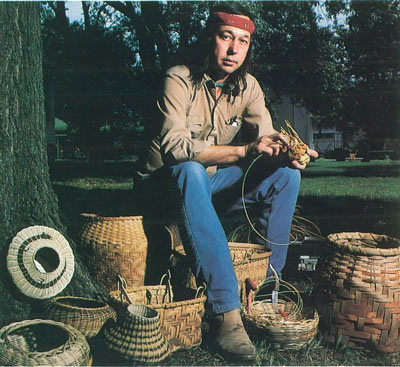TRADITIONAL CHEROKEE BASKETRY
Larry Croslin
Article:
Larry Croslin is a man with a mission, a prophet on a pilgrimage. And the message this part-Cherokee trumpets to fellow tribesmen and the populous at large? Never forget. How this blue-eyed basket weaver prevents amnesia about the cultures of the Five Civilized Tribes is working his craft and teaching it to others.

Larry Croslin constantly researches Indian weaving patterns and their variations. "If I can walk in a museum ... give me five minutes ... and the design will leave with me. If you can give me the material, I can make a basket out of it." |
|
According to 39-year-old Croslin, the Cherokee culture in its purest form was nearly obliterated by smallpox and war with English settlers. “Our culture effectively was destroyed. And we have a remnant of it in Oklahoma,” says Croslin. “What little we keep is in crafts, art and language.”
Others interested in preserving America’s Indian cultures appreciate Croslin’s commitment. “What makes his work so unique is he realizes the importance of his heritage … and the traditional values of it,” says Debra Synar, director of the Five Civilized Tribes Museum in Muskogee. “The quality of his work is excellent.”
Everything that goes into his baskets is as organic as the earth itself. Sometimes with a class in tow, he gathers natural materials, such as buckbrush, honeysuckle and white oak, from a farmstead or his own backyard. To treat white oak, he uses a pocket knife and wooden maul (most of his tools are handmade) to split the wood and strip the bark. For honeysuckle, he twists a web of vines into a wreath and dunks it in water to boil. Then he strips away the out sheath from the vines with a handful of bark and hangs it up to bleach in the sun. Selected strips are cooked in a broth with roots or nut shells, such as black walnut hulls, bloodroot and dyewood, producing shades of brown, orange and yellow.
“Sometimes the material takes longer to prepare than it does to make the basket,” says Croslin, who begin making Welsh baskets 25 years ago but became more interested in the weaving of his ancestors.
 Then comes craftwork. When indoors, he spreads a plastic cloth, and then his fingers fly. Surrounded by an array of tools – everything from a pocket knife to a deer antler – he twists the natural materials into strong-as-steel vessels in both traditional and contemporary styles.
Then comes craftwork. When indoors, he spreads a plastic cloth, and then his fingers fly. Surrounded by an array of tools – everything from a pocket knife to a deer antler – he twists the natural materials into strong-as-steel vessels in both traditional and contemporary styles.
His double-weave honeysuckle baskets are one intricate piece, woven to produce the look of a basket in a basket, sometimes with a special design and a splash of color hidden on the inner layer just for “orneriness,” he says. Although his white oak baskets are all traditional weaving patterns – peace pipe, Cherokee star, double-chief’s daughter and more – the other materials may be used in themes tried and true or variations thereon.
For this OG&E communications foreman who earns his daily bread thanks to 20th Century high technology, private time is spent in retrospection, bending Nature’s offerings into his own.
“You can step back 3,500 years when you walk through the door and start on this stuff,” he says.
Larry Croslin’s organic baskets are shown at the Five Civilized Tribes Museum in Muskogee. His prices vary from 420 to $600. For more information, contact him at PO Box 2608, Muskogee, OK 74402-2608, (918) 683-5363 (Remember the above info is from 1986)
Article: November-December 1986, Oklahoma Today
Back to Traditional Cherokee Basketry Page
Back to Top